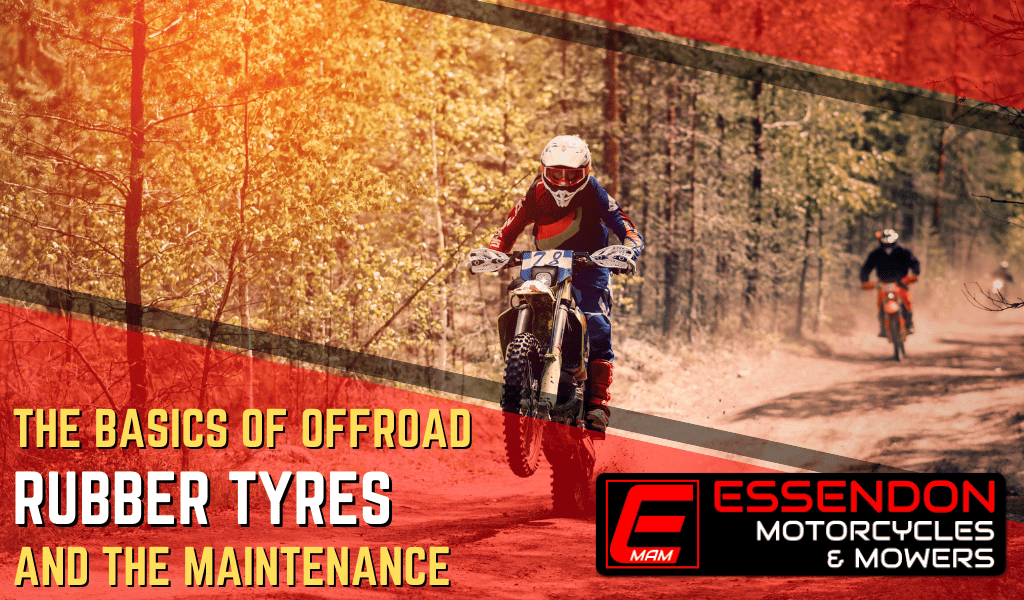The Basics of Off Road Rubber Tyres and the Maintenance!
The Basics of Off Road Rubber Tyres and The Maintenance Tips You Need to Know
Whether you are riding on road or off road tyres, the main thing you want to do remains the same: you want to stay on your bike, and preferably in an upright position. This basic principle applies to the tyres you use too, naturally. Almost as important, if not as immediate, is having some sort of wear strategy. However, the factors that influence the tyres when riding in the dirt are remarkably different, as are the conditions that we operate them in.
The ‘Land to Sea’ ratio, as the space between the blocks of rubber is referred to, is remarkably different to a road tyre. The thread depth is also remarkably different, with large blocks of rubber extruding from the body of the tyre. The area of these rubber blocks is pretty much matched by that of the thread.
The reason that the tyres are constructed in this way is to allow the motorcycle to gain tractionon mixed surfaces. Quite simply, the blocks of rubber dig into the ground – think of the way a paddle steamer propels itself through the water – and allow the bike to deliver successful drive.
In the broadest terms, and forgive us if we are being too obvious here, but off road tyres are rated by the terrain they are to be used on. Terms such as hard, medium, soft and sand are not the compounds of the tyres’ rubber, but rather, they are the types of surface they have been designed to be ridden on. Many of them now feature anti-rebound properties in the rubber itself on the rear tyres, which obviously makes for an altogether smoother landing!
Some of the problems associated with off road tyres are the blocks breaking off rather than wearing predictably. The other common problem is, not surprisingly given the types of surface involved, the issue of frequent punctures. Because of the terrain that off road bikes work on, they are much more susceptible to unintentional and unplanned stoppages, some of which can prove to be a little on the scary side if you are in full flow. The solution is to fit what’s known as a ‘mousse’.
These are quite simply a solid filler to insert in the tyre. They mimic a reasonably low pressure; accordingly the suspension needs to be tuned to work correctly with these. They also need to be fitted correctly. A mousse needs to be lubricated correctly, but very importantly, while the interior of the tyre needs to be well-lubed, it is very important not to make contact with the bead of the tyre. The lube will help the mousse remain intact when the bike is being ridden, often in an aggressive style, through an abrasive environment. Leaving the bead clean is essential to keeping the tyre on the rim.
The mousse and the tyre should always be replaced together.
Taking the idea of a mousse firmly into the future are TUBliss. This is a really clever system designed for off road tyres. In a discipline where low pressure is key, the lower limit is 12psi using a conventional tube or moose. That was until TUBliss came along. Replacing the inner tube, they fit directly to the rim, which they protect thanks to utilizing dual pressure zones.
The high pressure, up to 100 psi, tube replacement protects the rim from damage, while the rest of the tyre has little pressure allowing for more traction thanks to the larger contact patch. The high pressure protects the rim while the low pressure allows for increased drive and comfort. They are lighter than conventional tubes, fit stock wheels, and offer a higher standard of traction, control and protection than anything else on the market.
Here’s something that needs to be said: No full off road tyres will work well on the road. Applying the technology that allows them to work so well off road to a paved street creates far too many opportunities for catastrophe! For those of us who like to ride trails on road bikes, there are other options.
Designed for stability at speed, trail tyres are an excellent compromise between both on and off road. Their bias is towards road use, with a very different ‘Land to Sea’ ratio. The grooves are narrower, with many more smaller blocks. These blocks have multiple edges which allow for much more grip off road than a conventional street tyre, while the smaller threads work much better on solid road surfaces.
Whether you are fully focused on off road riding or just want to be able to take an occasional detour from streets, the main thing you need to remember is that it is important to have the right tyres.
To find out more about Essendon Motorcycles & Mowers and our services please contact us directly on (03) 9351 0055 or check out our website!

